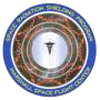 |
||
| Friday / 19 May 2006 | ||
Indian-American
Scientists Working on Biggest Challenge to Human Mission to Deep
Space. Ram Tripathi is leading a
group
of scientists working in the NASA Radiation Shielding Program
(logo imaged) that are developing radiation protection and shielding
technology for long-duration space journeys. "The intensity and
strength of cosmic radiation in deep space makes this a 'must solve'
problem for space missions," Tripathi says. Another Indian-American
scientist, Gautam Badhwar, has shown that robotic precursor missions
to Mars can provide valuable data on the radiation environment
to be encountered in future human missions. Both Tripathi and Badhwar
conclude that recent advances in hydrogen storage in graphite nanofibers
may have a large impact on radiation safety. Also, Galactic Cosmic
Rays (GCR), Solar Particle Events (SPE), and minimizing the production
of secondary radiation are factors to be considered. Scientists
are looking at a variety of materials containing different amounts
of hydrogen, which is the best for shielding, to solve the problem.
However, Indian-American scientist Premkumar Saganti believes that
"GCR are extremely penetrating and cannot be eliminated by practical
amounts of shielding." SPE could induce acute radiation syndromes,
including death, he adds. Although
Tripathi contends that current technology is adequate for single
lunar missions for astronauts, it is well known that in order to
have a permanent human presence on the Moon, the effects of long
exposures to cosmic radiation will have to be solved.
|
||
